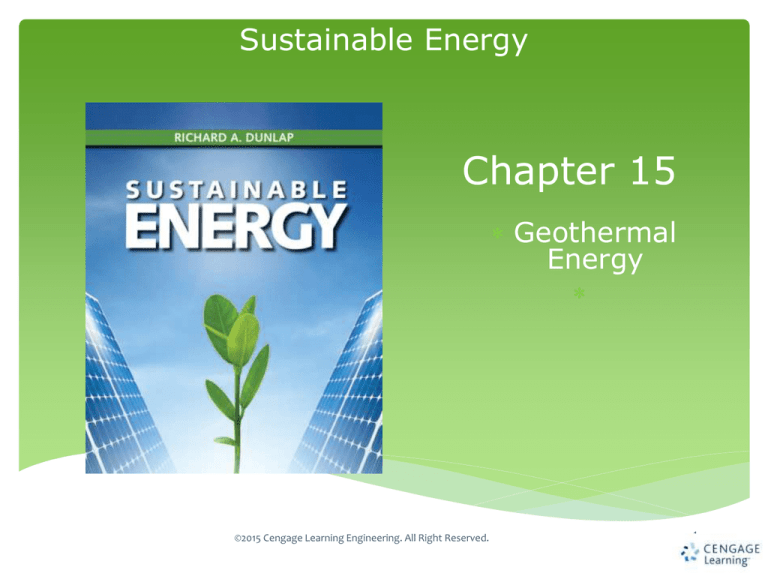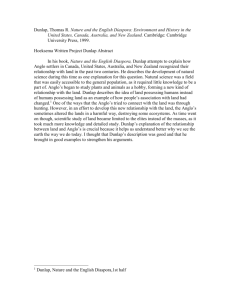
Sustainable Energy
Chapter 15
Geothermal
Energy
©2015 Cengage Learning Engineering. All Right Reserved.
1
Sustainable Energy
Dunlap
Learning Objectives
●
●
●
●
●
●
The reasons for geothermal energy.
The types and distribution of geothermal energy
resources.
The direct use of geothermal heat.
The types of geothermal electric generating
facilities.
The use of geothermal energy worldwide.
The sustainability and environmental
consequences of geothermal energy use.
©2015 Cengage Learning Engineering. All Right Reserved.
2
Sustainable Energy
Dunlap
The interior of the earth
The interior of the earth consists of various
layers:
•
•
•
•
•
crust
outer mantle
inner mantle
outer core
inner core
©2015 Cengage Learning Engineering. All Right Reserved.
3
Schematic of the interior of the earth
Sustainable Energy
Dunlap
Schematic of the interior of the earth
©2015 Cengage Learning Engineering. All Right Reserved.
4
Sustainable Energy
Dunlap
Dimensions of the earth's layers
©2015 Cengage Learning Engineering. All Right Reserved.
5
Sustainable Energy
Dunlap
Temperature inside the earth
The interior of the earth is hot. Heat comes
from several sources
• primordial heat
• decay of radioactive nuclides
• tidal friction in liquid core
Dominated by radioactive decay of U, Th and K
©2015 Cengage Learning Engineering. All Right Reserved.
6
Sustainable Energy
Dunlap
Distribution of geothermal heat flow
Average heat flow from interior of earth
0.087 W/m2
Small compared to solar insolation
(average 168 W/m2)
Distribution of geothermal heat flow determined by
variations in earth's structure
©2015 Cengage Learning Engineering. All Right Reserved.
7
Sustainable Energy
Dunlap
Regions of high thermal gradient
occur near regions where tectonic plates intersect
©2015 Cengage Learning Engineering. All Right Reserved.
8
Sustainable Energy
Dunlap
Classification of geothermal resources
•
•
•
•
•
•
Normal geothermal gradient (17 - 30 °C/km)
Hot dry rock
Hot water reservoirs
Natural steam reservoirs
Geopressurized regions
Magma
©2015 Cengage Learning Engineering. All Right Reserved.
9
Sustainable Energy
Dunlap
Geothermal gradients in the
United States
©2015 Cengage Learning Engineering. All Right Reserved.
10
Sustainable Energy
Dunlap
Possible applications of geothermal energy
Normal geothermal gradient
Temperature of about 200°C at a depth of 6 km
Not sufficient to make use of the thermal
energy as a method of electricity generation
Most useful for geothermal heat pumps
©2015 Cengage Learning Engineering. All Right Reserved.
11
Sustainable Energy
Dunlap
Hot dry rock
Gradient of > 40°C/km
Well drilled into thermal resource
Hydraulic fracturing used to create reservoir
Working fluid (water) injected to extract heat
Not commercially viable at this time
©2015 Cengage Learning Engineering. All Right Reserved.
12
Sustainable Energy
Dunlap
Hot water reservoirs
Regions of enhanced thermal gradient which
naturally contain water
Hot water may be extracted from wells
Hot water may be used for direct heating of
electricity generation
In widespread use
©2015 Cengage Learning Engineering. All Right Reserved.
13
Sustainable Energy
Dunlap
Natural steam reservoirs
Reservoirs in regions of enhanced gradient that
contain water primarily as steam
Easiest to utilize for electricity generation
Two major deposits: California and Italy
©2015 Cengage Learning Engineering. All Right Reserved.
14
Sustainable Energy
Dunlap
Geopressurized regions
Regions of hot pressurized water containing dissolved
methane gas
Mostly in Gulf of Mexico
Can be used as
• source of hot water for heating or electricity generation
• source of methane
• source of pressurized fluid to directly drive turbines to
generate electricity
First two have been implemented commercially
©2015 Cengage Learning Engineering. All Right Reserved.
15
Sustainable Energy
Dunlap
Magma
Not sufficiently stable to be used
commercially as a source of energy
©2015 Cengage Learning Engineering. All Right Reserved.
16
Sustainable Energy
Dunlap
Direct use of geothermal energy
Distribution of direct geothermal energy use
©2015 Cengage Learning Engineering. All Right Reserved.
17
Sustainable Energy
Dunlap
Some examples of direct geothermal heat
utilization
Geothermal aquaculture
©2015 Cengage Learning Engineering. All Right Reserved.
18
Sustainable Energy
Dunlap
Snow melting
©2015 Cengage Learning Engineering. All Right Reserved.
19
Sustainable Energy
Dunlap
Geothermal electricity
©2015 Cengage Learning Engineering. All Right Reserved.
20
Sustainable Energy
Dunlap
Production and injection wells
Hot fluid (water or steam) is extracted through
production wells.
After driving turbines it is reinjected through
injections wells to maintain reservoir fluid.
©2015 Cengage Learning Engineering. All Right Reserved.
21
Sustainable Energy
Dunlap
Dry steam plants
Steam from geothermal deposit is used to drive turbines
©2015 Cengage Learning Engineering. All Right Reserved.
22
Sustainable Energy
Dunlap
The Geysers in Northern California
typical generating stations are about 50 MWe
©2015 Cengage Learning Engineering. All Right Reserved.
23
Sustainable Energy
Flash steam plants
Dunlap
Used for deposits of hot pressurized water
Uses steam produced from pressurized hot water
by lowering the vapor pressure
Can also be used for direct heating applications
Most common type of geothermal generating
station
©2015 Cengage Learning Engineering. All Right Reserved.
24
Sustainable Energy
Dunlap
Schematic of flash steam plant
©2015 Cengage Learning Engineering. All Right Reserved.
25
Sustainable Energy
Dunlap
Flash steam plant in Otake, Japan
©2015 Cengage Learning Engineering. All Right Reserved.
26
Sustainable Energy
Dunlap
Binary cycle plants
Uses hot water or steam to heat another working fluid
through a heat exchanger
©2015 Cengage Learning Engineering. All Right Reserved.
27
Sustainable Energy
Dunlap
Binary cycle plant in Nevada
©2015 Cengage Learning Engineering. All Right Reserved.
28
Sustainable Energy
Dunlap
World utilization of geothermal energy
Installed capacity for geothermal electricity generation
©2015 Cengage Learning Engineering. All Right Reserved.
29
Sustainable Energy
Installed capacity for direct use of
geothermal energy
©2015 Cengage Learning Engineering. All Right Reserved.
30
Dunlap
Sustainable Energy
Dunlap
Distribution of geothermal generating
stations
Greatest utilization along tectonic plates that border the Asian
and North/Central American coasts of the Pacific
©2015 Cengage Learning Engineering. All Right Reserved.
31
Sustainable Energy
Dunlap
Growth of geothermal electricity
Substantial increase in use in early part of the 20th century,
relatively little growth since about 1980
©2015 Cengage Learning Engineering. All Right Reserved.
32
Sustainable Energy
Dunlap
Advantages of geothermal energy
• Simple well established technology
• Not subject to fluctuations such as
wind/solar/tidal/wave energy
• High energy density per unit land area
• Relatively safe with minimal environmental
impact
©2015 Cengage Learning Engineering. All Right Reserved.
33
Sustainable Energy
Dunlap
Disadvantages of geothermal energy
• Availability of additional resources is uncertain
• Heat is generally extracted faster than it can be
replenished leading to depletion of resource
• Water extracted from underground may contain
toxins and needs to be handled carefully
• Reinjection may lead to geological instability
(as in the case of fracking)
©2015 Cengage Learning Engineering. All Right Reserved.
34
Sustainable Energy
Dunlap
Summary
• Geothermal energy is associated with the thermal gradient
in the earth
• May be used directly for heating or for electricity
generation
• Most useful resources in regions of enhanced thermal
gradients near tectonic plate boundaries
• Hot water and steam resources most commonly used
• United States is the largest user of both direct geothermal
heat and geothermal electricity
• Additional capacity available worldwide may not be great
• Longevity may be uncertain
• Relatively low environmental impact
©2015 Cengage Learning Engineering. All Right Reserved.
35



